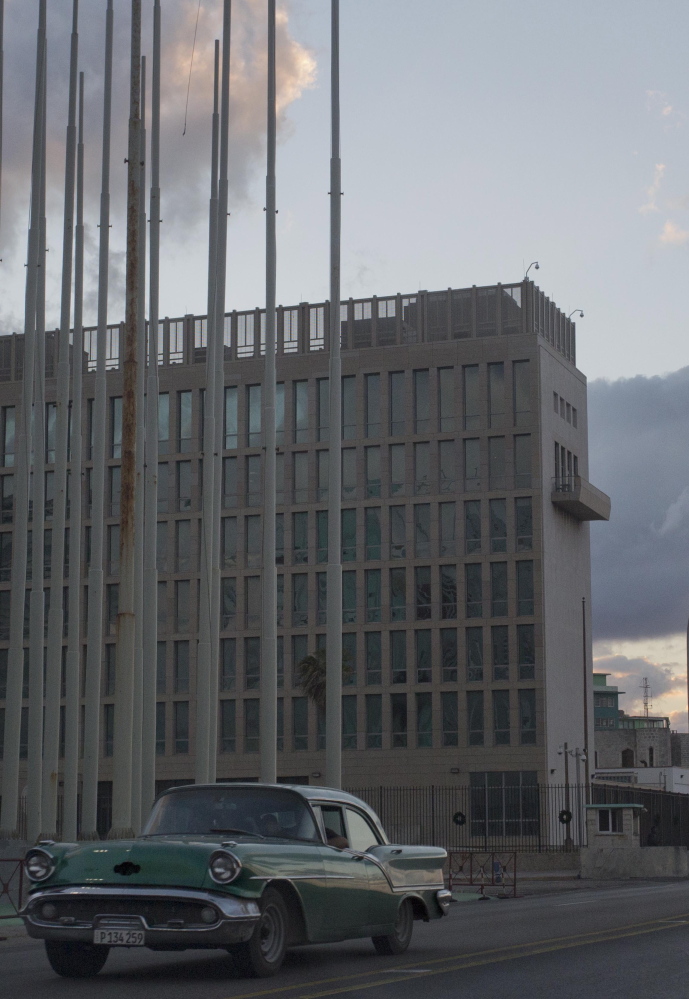HAVANA — A half-century after Washington severed relations with Cuba, the United States’ seven-story mission looms over Havana’s seaside Malecon boulevard as the largest diplomatic outpost in the country.
Cuban guards stand at close intervals on the street outside, and islanders line up by the thousands each year for a shot at a coveted visa.
The gleaming U.S. Interests Section suddenly is poised to become an even more important presence in Cuba as the two countries negotiate the first phase of their historic detente – transforming the complex into a full embassy that would reflect the Obama administration’s hopes of new influence on the communist island.
Roberta Jacobson, assistant U.S. secretary of state for Western Hemisphere affairs, will be the highest known U.S. administration official to visit in decades when she comes next month for annual talks on migration that will now also focus on the details of re-establishing full diplomatic relations.
The discussions are expected to cover expanding staffing in the two countries’ interests sections and letting diplomats travel outside their respective capitals without having to ask permission.
Also part of the reopening of the embassy: symbolic measures such as raising the American flag on the Malecon.
“Opening an embassy is a symbolic gesture, but symbols are really important,” John Caulfield, who was Interests Section chief from 2011 to 2014, said by phone from Jacksonville, Florida, where he retired.
“This is a pretty powerful symbol by our president that we want to have a more normal relationship with Cuba despite the fact that we have the obvious differences,” he added.
Cuba’s interests section is a stately manor in Washington’s Adams Morgan neighborhood. It, too, stands to become an embassy.
Diplomats say privately that Washington hopes to boost staffing in Havana, currently at about 50 Americans and 300 Cuban workers, as more American travelers and trade delegates are expected to come here under new rules to be set by the White House softening the U.S. trade embargo on Cuba.
The U.S. Interests Section has often been a flashpoint for conflict, and its decades of hybrid status reflect the dysfunctional relationship between the two deeply intertwined countries.
The building first opened as an embassy in 1953, the same year Fidel Castro launched an ill-fated assault on a barracks that is considered the onset of the Cuban Revolution.
Eight years later, with Castro then in power, the countries broke ties and Switzerland stepped in to safeguard both the embassy and the ambassador’s residence, a sprawling, immaculately groomed estate in Havana’s finest neighborhood.
After the break, Washington was without a presence in Cuba until 1977, when the interests sections were opened under President Jimmy Carter. The missions technically operate under the aegis of the “protecting power” Switzerland.
Cuba later built the adjacent “Anti-Imperialist Plaza,” which has hosted nationalist rallies where Castro gave long speeches railing against Washington.
On the wall of a conference room in the mission hangs the bronze head of an eagle that topped the nearby USS Maine monument until it was ripped down in a 1961 anti-Yankee protest following the failed Bay of Pigs invasion.
In 2006, U.S. diplomats abruptly installed an electronic billboard that scrolled messages extolling democracy and human rights to Cubans on the street below.
“The consequence of that was, for years, they did not allow us to import lightbulbs,” Caulfield recalled with a chuckle.
The U.S. Interests Section is closely watched by cameras and guards on both sides, a function of both the longtime tensions and general increased security at American diplomatic missions following 9/11. Cuban police make pedestrians cross the street to use another sidewalk, and no parking is allowed.
Some who served in the U.S. Interests Section are awaiting the change with a mixture of excitement and wistfulness at not being here for the transition.
“I would have loved to be there to raise that flag,” Caulfield said.
Send questions/comments to the editors.



Success. Please wait for the page to reload. If the page does not reload within 5 seconds, please refresh the page.
Enter your email and password to access comments.
Hi, to comment on stories you must . This profile is in addition to your subscription and website login.
Already have a commenting profile? .
Invalid username/password.
Please check your email to confirm and complete your registration.
Only subscribers are eligible to post comments. Please subscribe or login first for digital access. Here’s why.
Use the form below to reset your password. When you've submitted your account email, we will send an email with a reset code.